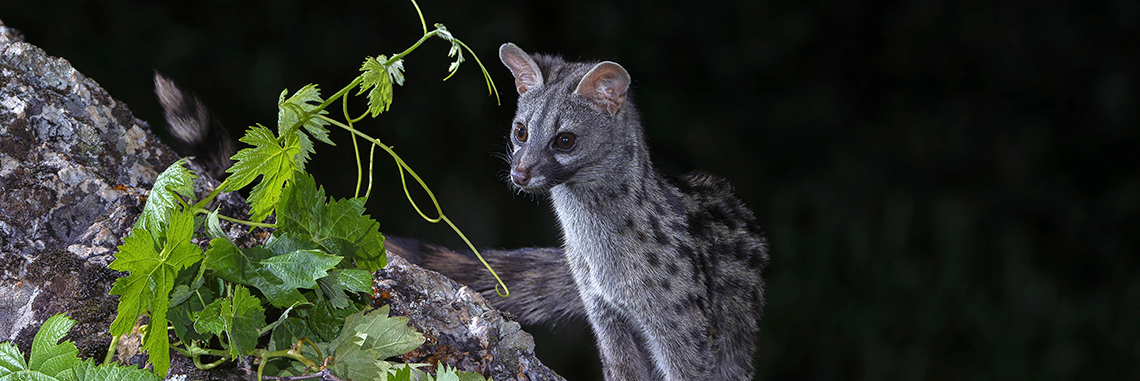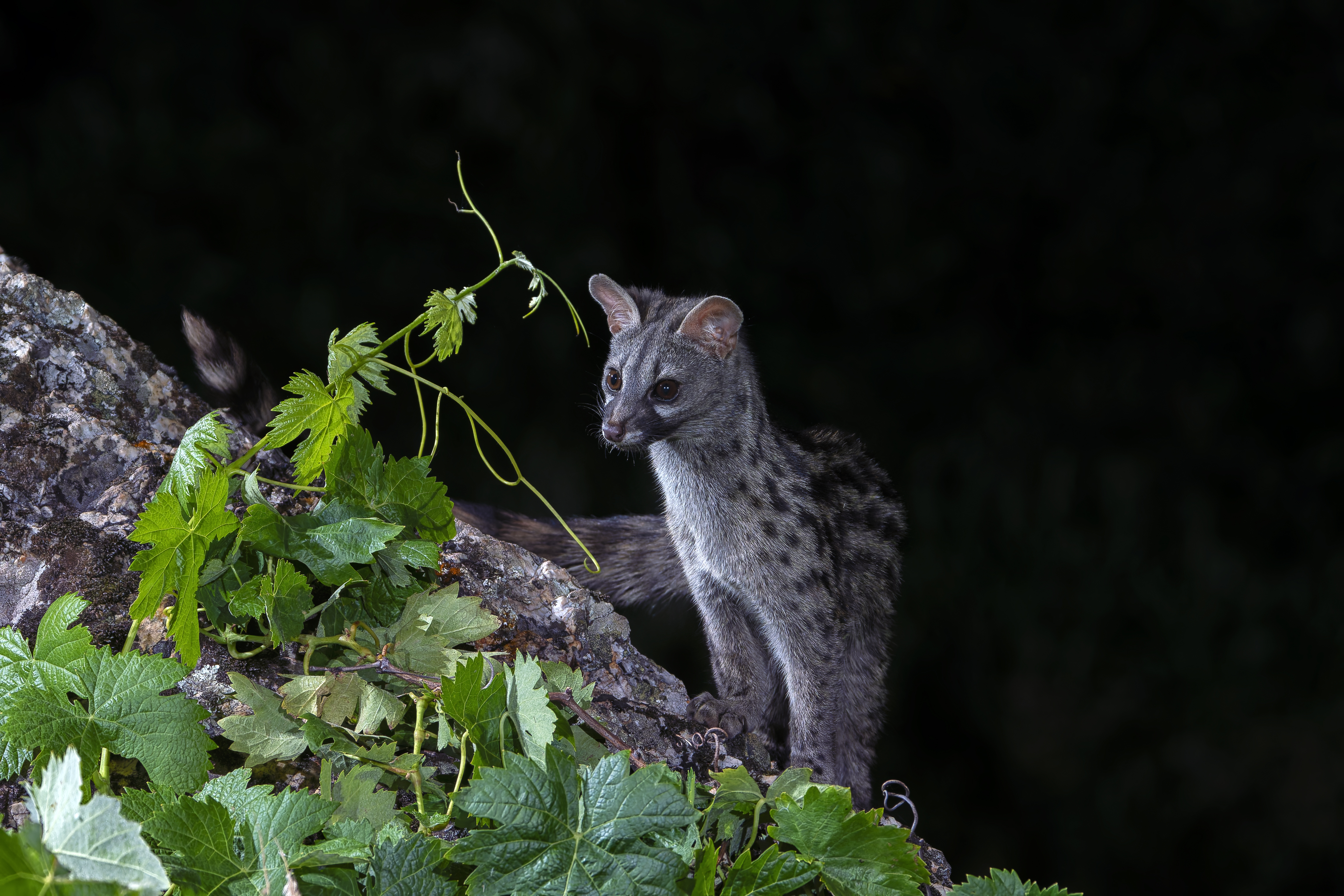The Vineyard Nights of the Genet

by Jose Luis Gallego, environmental communicator (@ecogallego)
Autumn nights, especially during full moon, are usually the best time to catch a rare glimpse of one of the most beautiful and elegant carnivores to roam the Mediterranean forest: the common or small-spotted genet (Genetta genetta). One of the best places to wait for such an opportunity is around a vineyard, especially those nestled into low mountain woodlands.

Illustration of a genet
Similar in size and shape to a cat (in some parts of Spain, the genet is also known as the gato almizclero or “musk cat”), this unique viverrid is among the most gifted camouflage artists of all Iberian fauna thanks to its spotted coat. So, if we want to observe one in the wild, we must pay close attention. Small-spotted genets have a long, slender body and a greyish brown coat dappled with black spots. Their tails are long and thick, sporting the same colours but ringed instead of spotted.
Adding to the genet’s elegant appearance are its short legs and small head, as well as its very fine, pointed muzzle with black whiskers and white snout. The ears are large and oval, and the white markings below the big caramel-coloured eyes enhance the animal’s already inquisitive gaze. Light and incredibly agile, common genets are just under a metre in length and weigh around two kilos.
A closer look at the mammal’s striking eyes reveals their most surprising feature: a vertical pupil, indicating a particular visual sensitivity ideal for hunting at night. The well-developed whiskers around the muzzle allow the genet to locate small ground-dwelling animals when it sniffs in and around dry leaves. The large ears contain one of the forest’s most finely attuned auditory organs that picks up on everything, even the breathing of a tiny vole hiding in its den. Using its fine, sharp, retractile claws, the genet is a skilful and nimble tree climber.
Some biologists support the theory that humans introduced the common genet to the Iberian Peninsula from Africa, most likely during the early period of Muslim rule. In the Arab world, the genet was historically kept as a pet. That said, recent archaeological findings suggest that the species already lived on the Peninsula before the Muslim armies arrived in 711.
In any case, since its arrival in Europe, the genet has adapted successfully to its adopted home and can be found in all ecosystems, from coastal areas to high mountains. Although it is primarily a sylvan species, which has found its favourite environment in the Mediterranean woodland, genets are also present in marshlands and riverside thickets. They are known to prowl rural environments and certain kinds of crop fields, especially olive groves or vineyards, where they go in search of easy prey.
Genets are omnivorous and hunt animals of any size, from small invertebrates to hares. Their diet varies depending on the season and the habitat they live in. Rodents and birds are a staple. In spring, genets are fond of hunting rodents and rabbits. During the summer, they incorporate amphibians, reptiles, and all kinds of invertebrates, and autumn sees the addition of wild fruits. During the winter, when prey is scarce in the mountains, genets prowl farmyards and stables in search of food, causing conflict with farmers who often consider them a pest.
However, the genet’s behavioural patterns and dietary habits show that in places where voles are abundant, they make up the bulk of its food supply – and in these cases, the genet becomes the farmer’s ally in controlling these rodent populations. Voles reproduce at incredible rates and when their numbers are too great, they can seriously damage crops, including vineyards.
Voles feed on the tips of clusters, buds, and vine shoots, which not only destroys the harvest but risks damaging the vines. As a result, winegrowers welcome the presence of genets in the forests surrounding their vineyards and wait for them to prowl the vine rows after nightfall to help mitigate the damage.
Under the right conditions, this feliform viverrid can breed twice a year: at the beginning of the year and in autumn, with October seeing the greatest number of births. Litters usually consist of two to three kits.
The species’ distribution extends across Africa, the Arabian Peninsula, and southwestern Europe, where it is a relative newcomer with no known fossil findings. It can be found in Spain, Portugal, and southwestern France. On the Iberian Peninsula, genet populations seem to decrease from the southwest to the northeast, with almost none or very few in the grain-producing areas of the Northern Plateau. Genets are present on the islands of Mallorca, Cabrera, and Ibiza, where biologists have identified a subspecies: Genetta genetta isabelae. There are no genets on the Canary Islands.
The common genet enjoys strict legal protections, meaning it cannot be captured or hunted. Generally, the status of genets is listed as least concern by the International Union for Conservation of Nature (IUCN), except for the Ibizan subspecies, which is listed as vulnerable. The main threats that genets face include car collisions, poaching, wildfires, and the illegal use of poison in agricultural areas, as well as the deterioration of their habitats.
